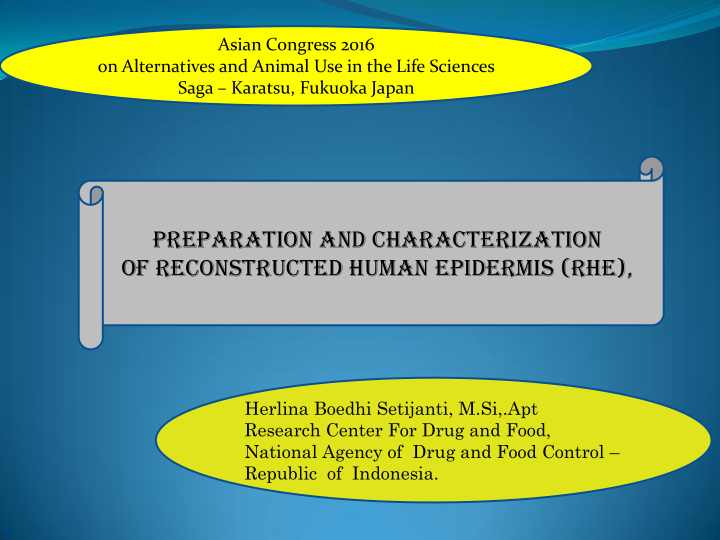



Asian Congress 2016 on Alternatives and Animal Use in the Life Sciences Saga – Karatsu, Fukuoka Japan Preparation and characterization of RECONSTRuCTED HUMAN EPIDERMIS (RHE), Herlina Boedhi Setijanti, M.Si,.Apt Research Center For Drug and Food, National Agency of Drug and Food Control – Republic of Indonesia.
Background In the health sector in Indonesia, testing of skin irritation is still using animals ( in vivo methods). But animal welfare issues causing restrictions on the use of animals in testing. T o solve this problems we develop a method of in vitro using skin model of Reconstructed Human Epidermis (RHE).
• Procurement of artificial skin irritation model of the RHE in Indonesia is not easy because it must to import from abroad and requires a high cost. And even special handling is needed for the RHE because it is a living tissue • Which is more particularly is derived from the skin of commercial RHE not Indonesian
• Therefore the Research Center of Drug and Food (RCDF) conducting research of the RHE preparation and characterization. Our research started in 2014 • In 2014 we successful isolation and purification of the three types of cells used in the manufacture of the RHE, in 2015 doing network reconstruction of the RHE, in 2016 will perform tissue characterization of the RHE and next 2017 is planned to conduct a validation test
PROCEDURE Dermis in the MK Wash with a solution fibroblasts separated of betadin fibroblast cells konfluen colagen The epidermis Soaked in trypsin EDTA and incubated Sircumcision tissue in the overnight in the refrigerator Dermis layer medium trasport Melanocyte cells in the MK melanocytes Reconstruction dermis layer of the epidermis layer, which is cultured in steril ring in IMDM medium Melanocyte cells konfluen Keratinocyte cells konfluen 1 : 40 RHE Epidermis layer
Target cells are cells keratinocytes, melanocytes and fibroblasts were isolated using a different culture medium and then the morphology seen by comparing the existing literature. Cell purification is done by magnetic beads Feeder layer (dermis equivalent) is formed of fibroblasts and collagen, which serves as the framework in the manufacture of RHE
keratinocyte cell was observed at day 7 with Confluent keratinocyte cells inverted microscope with a was observed at day 11 with magnification of 100 x inverted microscope with a magnification of 100 x
Melanocyte cells was observed at day 3 with Confluent melanocytes cells inverted microscope with a was observed at day 6 with magnification of 100 x inverted microscope with a magnification of 100 x
Fibroblast cells was observed at day 4 with inverted Confluent fibroblast cells was microscope with a observed at day 7 with inverted magnification of 100 x microscope with a magnification of 100 x
• The manufacture of RHE is by making Feeder layer (dermis equivalent) which is formed from a mixture of fibroblasts and collagen as scafold (frame), that layer of the dermis equivalent is placed insert / propylene sterile ring, then put a layer of epidermis consists of cells keratinocytes and melanocytes with a ratio of 40: 1 • Then measured the percentage of cell life on day 1 (as a baseline), day 3, day 7, day 11 and day 14, while on the 15th day histopathology examination do
The making of the epidermal layer is repeated by lowering the number of cell implantation, the keratinocyte cell 10 x 10 4 cells / mL and melanocyte cells 0.25 x 10 4 cells / mL of the number of cells that were grown on the first try and the result on day 11, still visible increase in the percentage of cell life.
CONCLUSIONS Research Center of Drug and Food can produce a more representative RHE typical Indonesia people, because the source and composition of cells derived from the skin of Indonesia.
• The percentage of living epidermal cells grow well at planting keratinocyte cell 10 x 10 4 cells / mL and melanocyte cells 0.25 x 10 4 cells / mL and survived until day 11 with a percentage of 93,45 % of living cells. • In the histopathology seen their cell stacks, but have not been integrated to form the tissue.
In 2015, this research selected was awarded as one of the works most prospective innovation Indonesia for the category "Health and Medicine", published in the book "107 Indonesia Innovations Prospective 2015 “ issued by the Business Innovation Center (BIC) in collaboration with the Innovation Center – Indonesian Institute of Sciences is supported by the Ministry of Research, Technology and Higher Education of the Republic of Indonesia.
Thank you
Recommend
More recommend